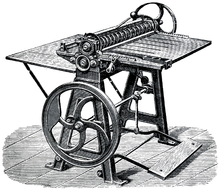Card stock


Card stock, also called cover stock or pasteboard, is a paper stock that is thicker and more durable than normal writing or printing paper, but thinner and more flexible than other forms of paperboard.
Card stock is often used for business cards, postcards, playing cards, catalogue covers, scrapbooking, and other uses which require higher durability than regular paper. The texture is usually smooth, but can be textured, metallic, or glossy. When card stock is labeled as cover stock it often has a coated finish on one side or both sides (C1S or C2S, for Coated: One Side, or Coated: Two Sides) to produce a glossy look and smooth texture, especially in use for the printing of business cards and book covers.[1]
Measurements
Most countries use the term grammage is used to describe the weight of the paper in grams per square metre. The term card stock is used to describe paper with weights from 50 lb to 110 lb (about 135 to 300 g/m2).[2] Alternatively, grammage can be expressed in terms of the weight per number of sheets, pound weight - the weight of 500 sheets of 20 by 26 in (508 by 660 mm) paper.[3]
In the U.S., card stock thickness is usually measured in points or mils; the thickness of the sheet in thousandths of an inch. For example, a 10 pt. card is 0.010 in (0.254 mm) thick (roughly corresponding to a weight of 250 g/m2); 12 pt. is 0.012 in (0.3048 mm). The U.S. Card Stock Thickness Point size is 0.001"[4] - not to be confused with typographical point size, where 1 point = 1/ 12 traditional pica = exactly 0.01383 inch = 0.35136 mm.
Paper sizes using the ISO system are often used for card stock. Card stock sizes can be labeled as A3 (420 × 297 mm or 16.5 × 11.7 in) referencing the ISO Standard system, instead of using the physical dimensions to describe its size.[5][6]
See also
References
- ↑ "Paper Weight, Paper Size, Coated Paper, Matte Paper". Printing Industry Exchange, LLC. Nov 2004.
- ↑ "Paper and Card Stock Comparison Chart" (PDF). The Paper Mill Store. Retrieved 3 April 2013.
- ↑ This differs from how text stock is determined, which assumes 500 sheets of 25 by 38 in (635 by 965 mm) paper. Because of the difference in the way text and card stock pound weight is determined, a sheet of 65# card stock is actually thicker and heavier than a sheet of 80# text.
- ↑ "Let's End the "Paper Weight" Confusion".
- ↑ "Paper Sizes".
- ↑ "Understanding Card Stock Weights".